HMSV 3502: Analyzing Issues in Health and Human Services Management
VerifiedAdded on 2023/06/11
|8
|1906
|493
Essay
AI Summary
This essay explores various factors affecting health service delivery and management, including social, environmental, economic, and personal elements. It emphasizes the importance of health literacy, ethical decision-making, and critical thinking in addressing these issues. The essay also reflects on how personal values and beliefs can influence actions in health service management. Furthermore, it identifies poor communication skills as a significant challenge in the industry and proposes strategies to improve communication, such as cultural sensitivity training and policy development. The essay utilizes theoretical perspectives, including cognitive and humanistic approaches, to understand and resolve problems within health and human service organizations. Desklib offers a variety of resources, including solved assignments and past papers, to aid students in their studies.
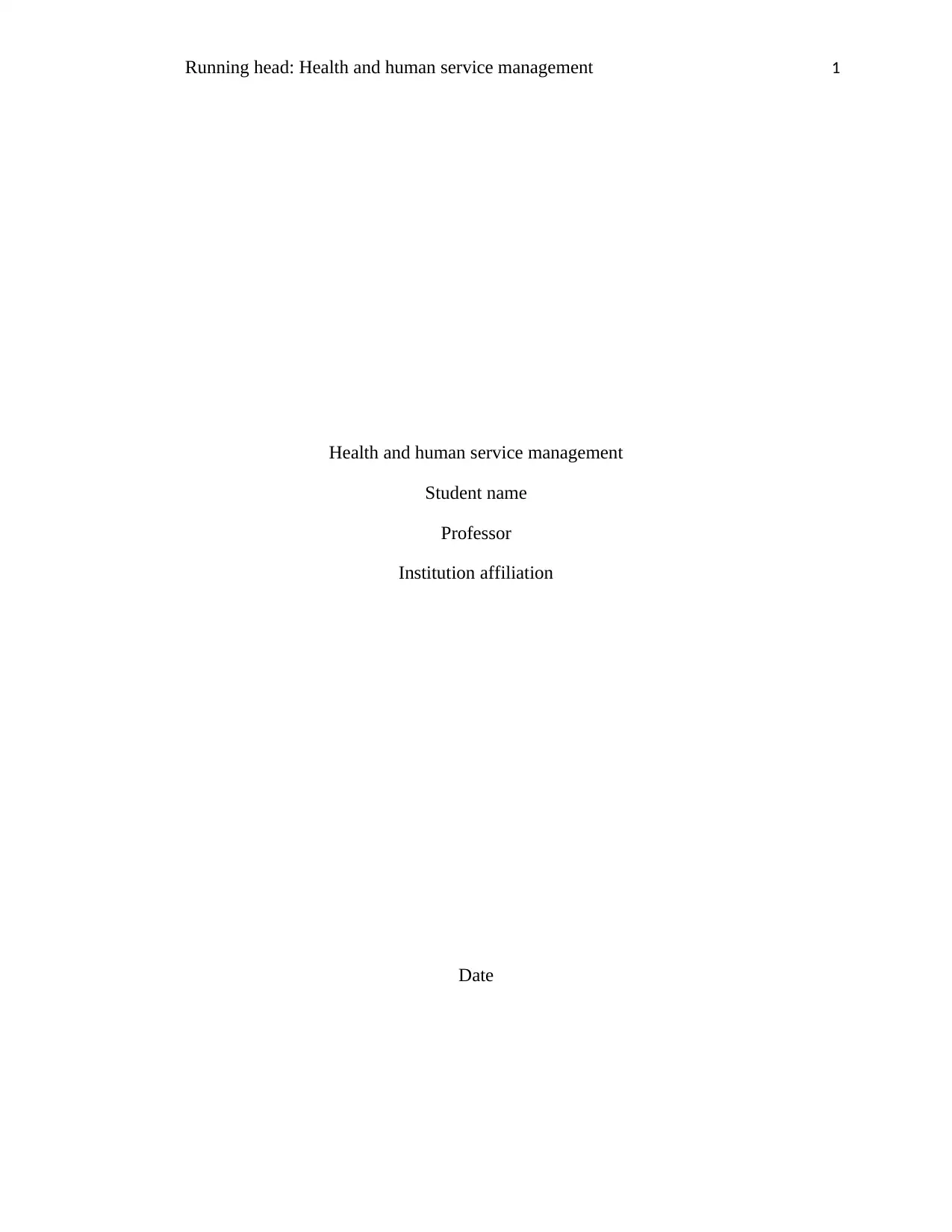
Running head: Health and human service management 1
Health and human service management
Student name
Professor
Institution affiliation
Date
Health and human service management
Student name
Professor
Institution affiliation
Date
Paraphrase This Document
Need a fresh take? Get an instant paraphrase of this document with our AI Paraphraser
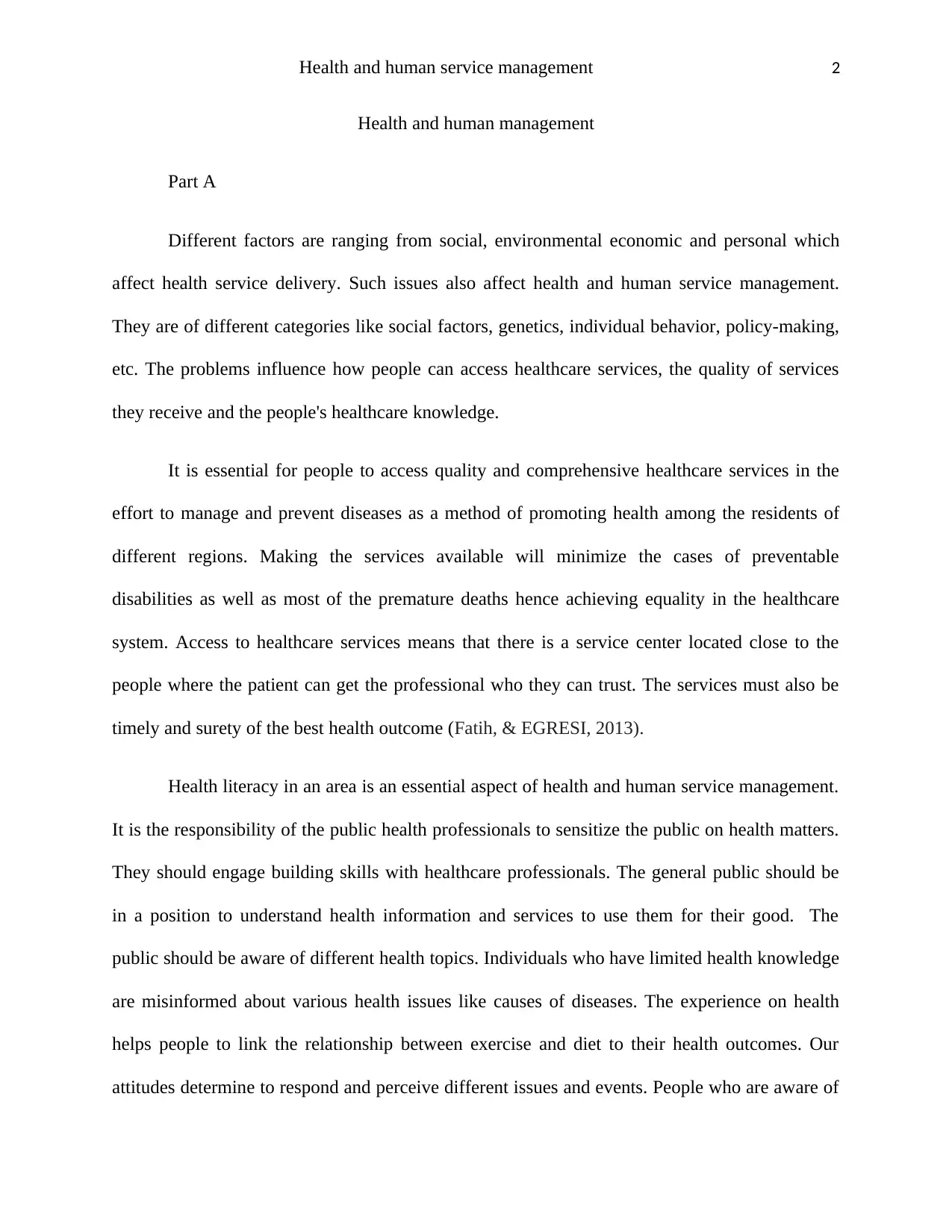
Health and human service management 2
Health and human management
Part A
Different factors are ranging from social, environmental economic and personal which
affect health service delivery. Such issues also affect health and human service management.
They are of different categories like social factors, genetics, individual behavior, policy-making,
etc. The problems influence how people can access healthcare services, the quality of services
they receive and the people's healthcare knowledge.
It is essential for people to access quality and comprehensive healthcare services in the
effort to manage and prevent diseases as a method of promoting health among the residents of
different regions. Making the services available will minimize the cases of preventable
disabilities as well as most of the premature deaths hence achieving equality in the healthcare
system. Access to healthcare services means that there is a service center located close to the
people where the patient can get the professional who they can trust. The services must also be
timely and surety of the best health outcome (Fatih, & EGRESI, 2013).
Health literacy in an area is an essential aspect of health and human service management.
It is the responsibility of the public health professionals to sensitize the public on health matters.
They should engage building skills with healthcare professionals. The general public should be
in a position to understand health information and services to use them for their good. The
public should be aware of different health topics. Individuals who have limited health knowledge
are misinformed about various health issues like causes of diseases. The experience on health
helps people to link the relationship between exercise and diet to their health outcomes. Our
attitudes determine to respond and perceive different issues and events. People who are aware of
Health and human management
Part A
Different factors are ranging from social, environmental economic and personal which
affect health service delivery. Such issues also affect health and human service management.
They are of different categories like social factors, genetics, individual behavior, policy-making,
etc. The problems influence how people can access healthcare services, the quality of services
they receive and the people's healthcare knowledge.
It is essential for people to access quality and comprehensive healthcare services in the
effort to manage and prevent diseases as a method of promoting health among the residents of
different regions. Making the services available will minimize the cases of preventable
disabilities as well as most of the premature deaths hence achieving equality in the healthcare
system. Access to healthcare services means that there is a service center located close to the
people where the patient can get the professional who they can trust. The services must also be
timely and surety of the best health outcome (Fatih, & EGRESI, 2013).
Health literacy in an area is an essential aspect of health and human service management.
It is the responsibility of the public health professionals to sensitize the public on health matters.
They should engage building skills with healthcare professionals. The general public should be
in a position to understand health information and services to use them for their good. The
public should be aware of different health topics. Individuals who have limited health knowledge
are misinformed about various health issues like causes of diseases. The experience on health
helps people to link the relationship between exercise and diet to their health outcomes. Our
attitudes determine to respond and perceive different issues and events. People who are aware of
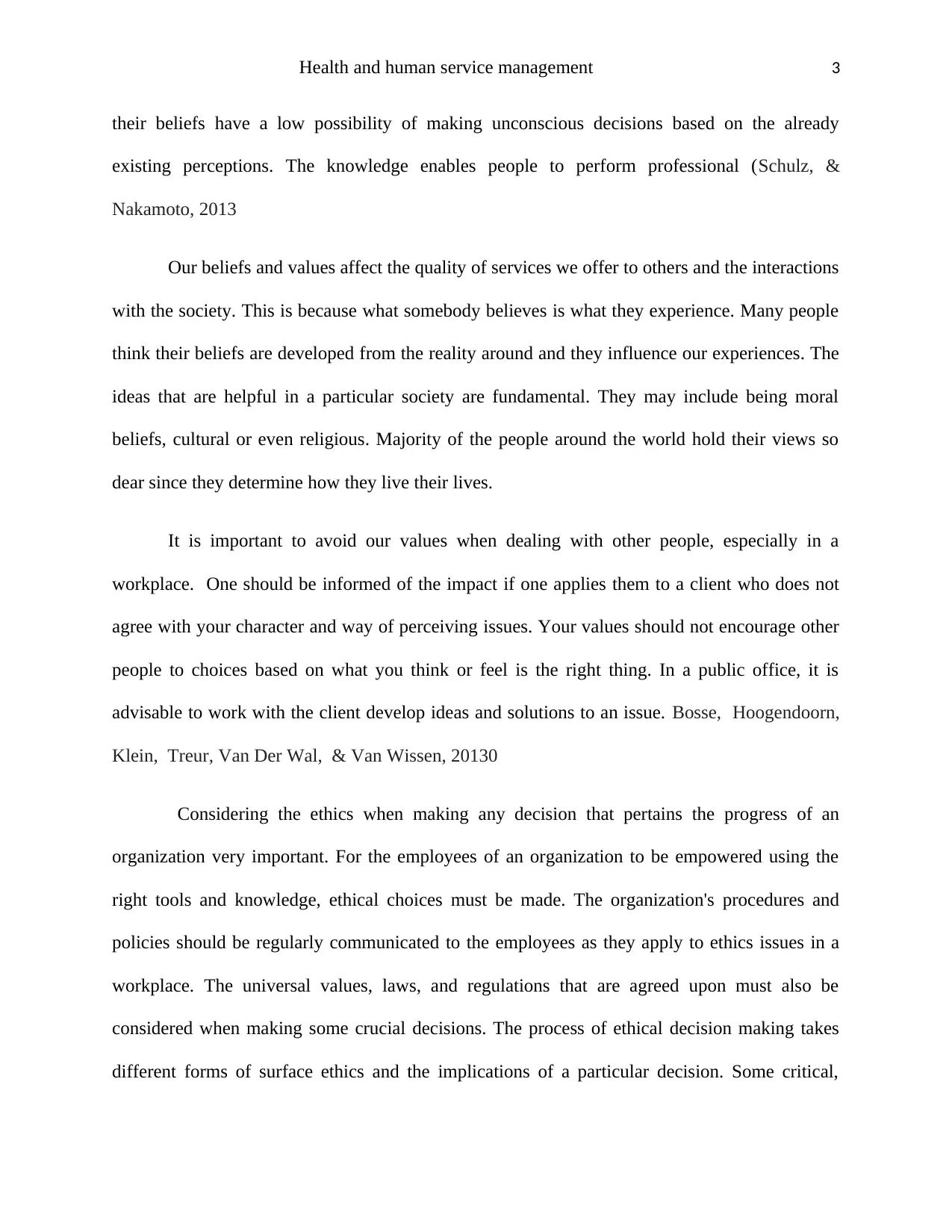
Health and human service management 3
their beliefs have a low possibility of making unconscious decisions based on the already
existing perceptions. The knowledge enables people to perform professional (Schulz, &
Nakamoto, 2013
Our beliefs and values affect the quality of services we offer to others and the interactions
with the society. This is because what somebody believes is what they experience. Many people
think their beliefs are developed from the reality around and they influence our experiences. The
ideas that are helpful in a particular society are fundamental. They may include being moral
beliefs, cultural or even religious. Majority of the people around the world hold their views so
dear since they determine how they live their lives.
It is important to avoid our values when dealing with other people, especially in a
workplace. One should be informed of the impact if one applies them to a client who does not
agree with your character and way of perceiving issues. Your values should not encourage other
people to choices based on what you think or feel is the right thing. In a public office, it is
advisable to work with the client develop ideas and solutions to an issue. Bosse, Hoogendoorn,
Klein, Treur, Van Der Wal, & Van Wissen, 20130
Considering the ethics when making any decision that pertains the progress of an
organization very important. For the employees of an organization to be empowered using the
right tools and knowledge, ethical choices must be made. The organization's procedures and
policies should be regularly communicated to the employees as they apply to ethics issues in a
workplace. The universal values, laws, and regulations that are agreed upon must also be
considered when making some crucial decisions. The process of ethical decision making takes
different forms of surface ethics and the implications of a particular decision. Some critical,
their beliefs have a low possibility of making unconscious decisions based on the already
existing perceptions. The knowledge enables people to perform professional (Schulz, &
Nakamoto, 2013
Our beliefs and values affect the quality of services we offer to others and the interactions
with the society. This is because what somebody believes is what they experience. Many people
think their beliefs are developed from the reality around and they influence our experiences. The
ideas that are helpful in a particular society are fundamental. They may include being moral
beliefs, cultural or even religious. Majority of the people around the world hold their views so
dear since they determine how they live their lives.
It is important to avoid our values when dealing with other people, especially in a
workplace. One should be informed of the impact if one applies them to a client who does not
agree with your character and way of perceiving issues. Your values should not encourage other
people to choices based on what you think or feel is the right thing. In a public office, it is
advisable to work with the client develop ideas and solutions to an issue. Bosse, Hoogendoorn,
Klein, Treur, Van Der Wal, & Van Wissen, 20130
Considering the ethics when making any decision that pertains the progress of an
organization very important. For the employees of an organization to be empowered using the
right tools and knowledge, ethical choices must be made. The organization's procedures and
policies should be regularly communicated to the employees as they apply to ethics issues in a
workplace. The universal values, laws, and regulations that are agreed upon must also be
considered when making some crucial decisions. The process of ethical decision making takes
different forms of surface ethics and the implications of a particular decision. Some critical,
⊘ This is a preview!⊘
Do you want full access?
Subscribe today to unlock all pages.

Trusted by 1+ million students worldwide
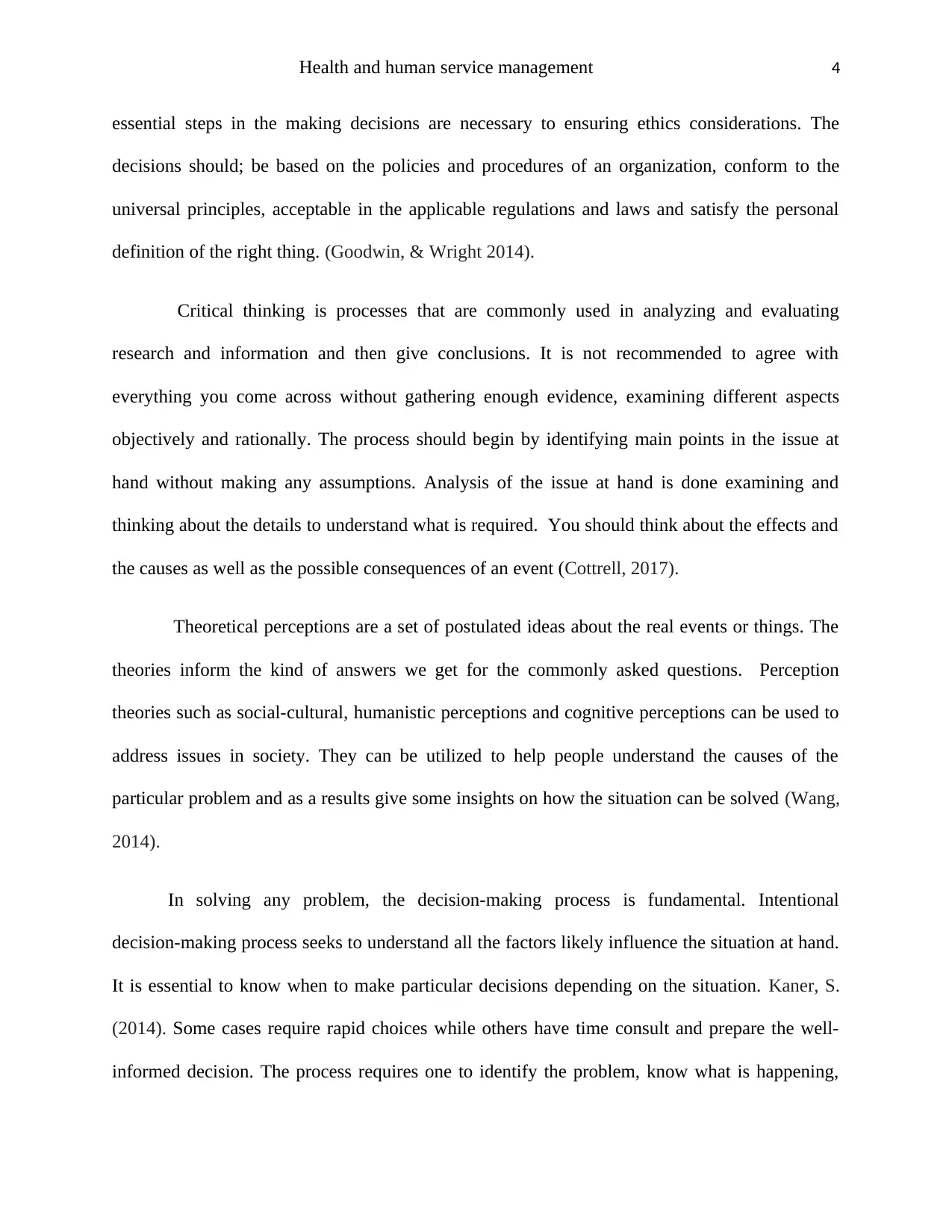
Health and human service management 4
essential steps in the making decisions are necessary to ensuring ethics considerations. The
decisions should; be based on the policies and procedures of an organization, conform to the
universal principles, acceptable in the applicable regulations and laws and satisfy the personal
definition of the right thing. (Goodwin, & Wright 2014).
Critical thinking is processes that are commonly used in analyzing and evaluating
research and information and then give conclusions. It is not recommended to agree with
everything you come across without gathering enough evidence, examining different aspects
objectively and rationally. The process should begin by identifying main points in the issue at
hand without making any assumptions. Analysis of the issue at hand is done examining and
thinking about the details to understand what is required. You should think about the effects and
the causes as well as the possible consequences of an event (Cottrell, 2017).
Theoretical perceptions are a set of postulated ideas about the real events or things. The
theories inform the kind of answers we get for the commonly asked questions. Perception
theories such as social-cultural, humanistic perceptions and cognitive perceptions can be used to
address issues in society. They can be utilized to help people understand the causes of the
particular problem and as a results give some insights on how the situation can be solved (Wang,
2014).
In solving any problem, the decision-making process is fundamental. Intentional
decision-making process seeks to understand all the factors likely influence the situation at hand.
It is essential to know when to make particular decisions depending on the situation. Kaner, S.
(2014). Some cases require rapid choices while others have time consult and prepare the well-
informed decision. The process requires one to identify the problem, know what is happening,
essential steps in the making decisions are necessary to ensuring ethics considerations. The
decisions should; be based on the policies and procedures of an organization, conform to the
universal principles, acceptable in the applicable regulations and laws and satisfy the personal
definition of the right thing. (Goodwin, & Wright 2014).
Critical thinking is processes that are commonly used in analyzing and evaluating
research and information and then give conclusions. It is not recommended to agree with
everything you come across without gathering enough evidence, examining different aspects
objectively and rationally. The process should begin by identifying main points in the issue at
hand without making any assumptions. Analysis of the issue at hand is done examining and
thinking about the details to understand what is required. You should think about the effects and
the causes as well as the possible consequences of an event (Cottrell, 2017).
Theoretical perceptions are a set of postulated ideas about the real events or things. The
theories inform the kind of answers we get for the commonly asked questions. Perception
theories such as social-cultural, humanistic perceptions and cognitive perceptions can be used to
address issues in society. They can be utilized to help people understand the causes of the
particular problem and as a results give some insights on how the situation can be solved (Wang,
2014).
In solving any problem, the decision-making process is fundamental. Intentional
decision-making process seeks to understand all the factors likely influence the situation at hand.
It is essential to know when to make particular decisions depending on the situation. Kaner, S.
(2014). Some cases require rapid choices while others have time consult and prepare the well-
informed decision. The process requires one to identify the problem, know what is happening,
Paraphrase This Document
Need a fresh take? Get an instant paraphrase of this document with our AI Paraphraser
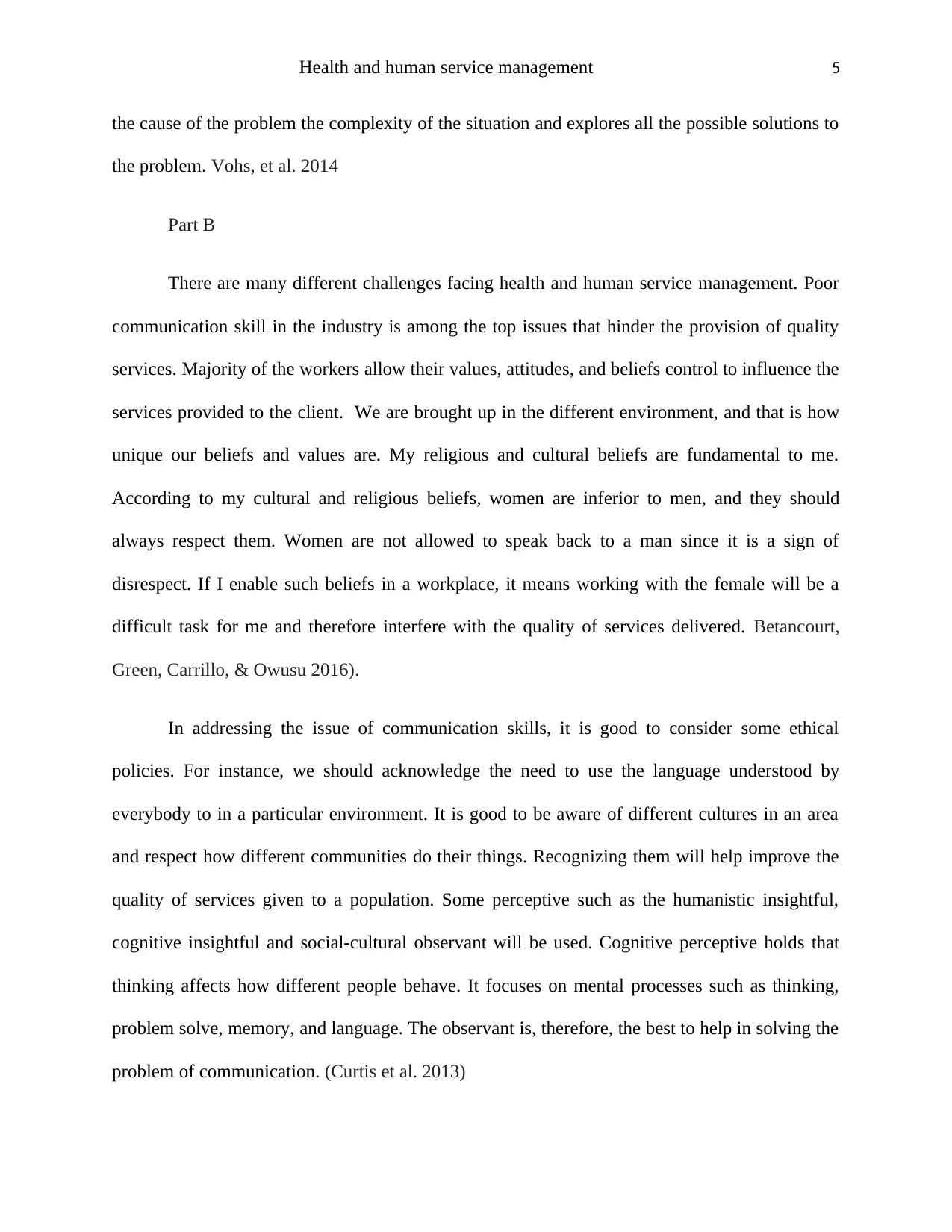
Health and human service management 5
the cause of the problem the complexity of the situation and explores all the possible solutions to
the problem. Vohs, et al. 2014
Part B
There are many different challenges facing health and human service management. Poor
communication skill in the industry is among the top issues that hinder the provision of quality
services. Majority of the workers allow their values, attitudes, and beliefs control to influence the
services provided to the client. We are brought up in the different environment, and that is how
unique our beliefs and values are. My religious and cultural beliefs are fundamental to me.
According to my cultural and religious beliefs, women are inferior to men, and they should
always respect them. Women are not allowed to speak back to a man since it is a sign of
disrespect. If I enable such beliefs in a workplace, it means working with the female will be a
difficult task for me and therefore interfere with the quality of services delivered. Betancourt,
Green, Carrillo, & Owusu 2016).
In addressing the issue of communication skills, it is good to consider some ethical
policies. For instance, we should acknowledge the need to use the language understood by
everybody to in a particular environment. It is good to be aware of different cultures in an area
and respect how different communities do their things. Recognizing them will help improve the
quality of services given to a population. Some perceptive such as the humanistic insightful,
cognitive insightful and social-cultural observant will be used. Cognitive perceptive holds that
thinking affects how different people behave. It focuses on mental processes such as thinking,
problem solve, memory, and language. The observant is, therefore, the best to help in solving the
problem of communication. (Curtis et al. 2013)
the cause of the problem the complexity of the situation and explores all the possible solutions to
the problem. Vohs, et al. 2014
Part B
There are many different challenges facing health and human service management. Poor
communication skill in the industry is among the top issues that hinder the provision of quality
services. Majority of the workers allow their values, attitudes, and beliefs control to influence the
services provided to the client. We are brought up in the different environment, and that is how
unique our beliefs and values are. My religious and cultural beliefs are fundamental to me.
According to my cultural and religious beliefs, women are inferior to men, and they should
always respect them. Women are not allowed to speak back to a man since it is a sign of
disrespect. If I enable such beliefs in a workplace, it means working with the female will be a
difficult task for me and therefore interfere with the quality of services delivered. Betancourt,
Green, Carrillo, & Owusu 2016).
In addressing the issue of communication skills, it is good to consider some ethical
policies. For instance, we should acknowledge the need to use the language understood by
everybody to in a particular environment. It is good to be aware of different cultures in an area
and respect how different communities do their things. Recognizing them will help improve the
quality of services given to a population. Some perceptive such as the humanistic insightful,
cognitive insightful and social-cultural observant will be used. Cognitive perceptive holds that
thinking affects how different people behave. It focuses on mental processes such as thinking,
problem solve, memory, and language. The observant is, therefore, the best to help in solving the
problem of communication. (Curtis et al. 2013)
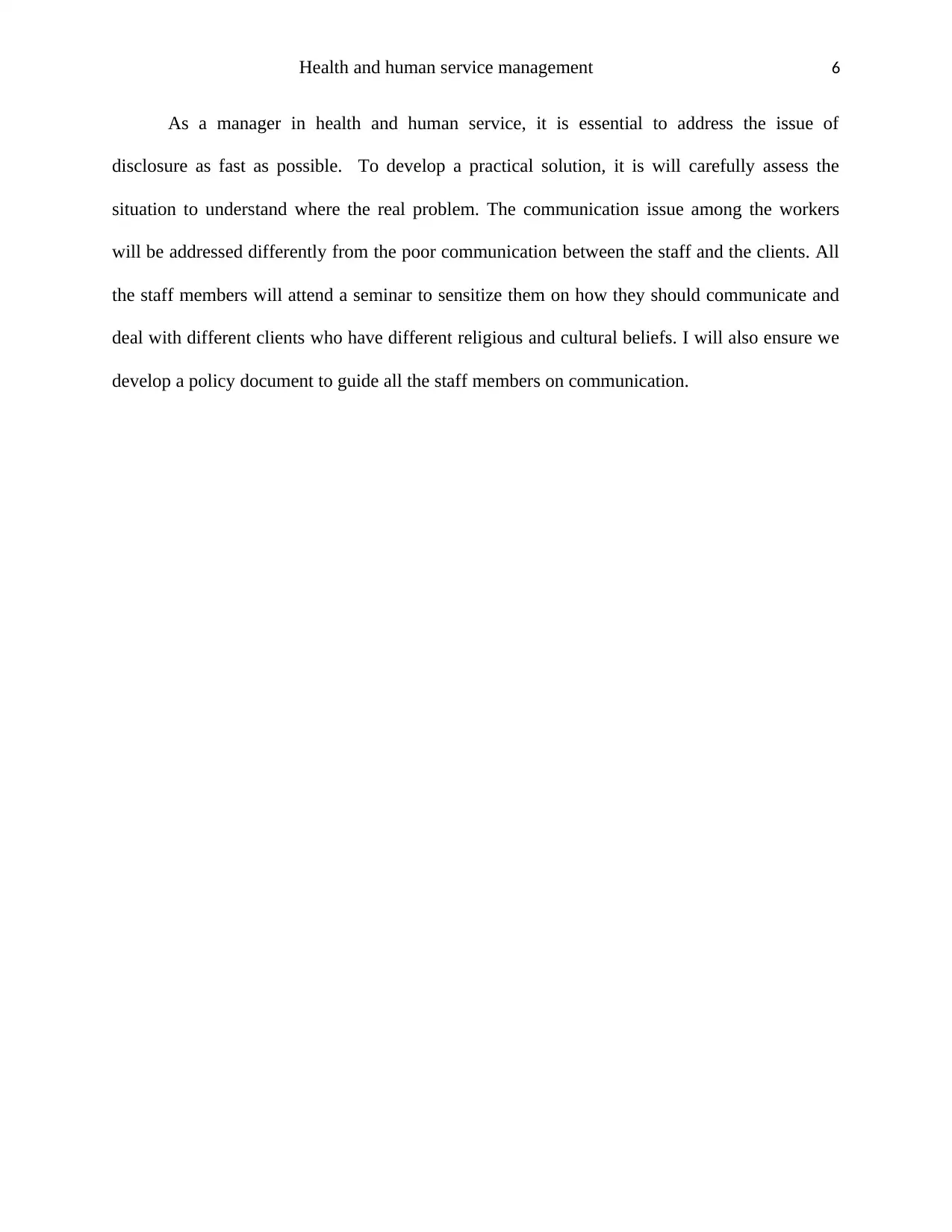
Health and human service management 6
As a manager in health and human service, it is essential to address the issue of
disclosure as fast as possible. To develop a practical solution, it is will carefully assess the
situation to understand where the real problem. The communication issue among the workers
will be addressed differently from the poor communication between the staff and the clients. All
the staff members will attend a seminar to sensitize them on how they should communicate and
deal with different clients who have different religious and cultural beliefs. I will also ensure we
develop a policy document to guide all the staff members on communication.
As a manager in health and human service, it is essential to address the issue of
disclosure as fast as possible. To develop a practical solution, it is will carefully assess the
situation to understand where the real problem. The communication issue among the workers
will be addressed differently from the poor communication between the staff and the clients. All
the staff members will attend a seminar to sensitize them on how they should communicate and
deal with different clients who have different religious and cultural beliefs. I will also ensure we
develop a policy document to guide all the staff members on communication.
⊘ This is a preview!⊘
Do you want full access?
Subscribe today to unlock all pages.

Trusted by 1+ million students worldwide
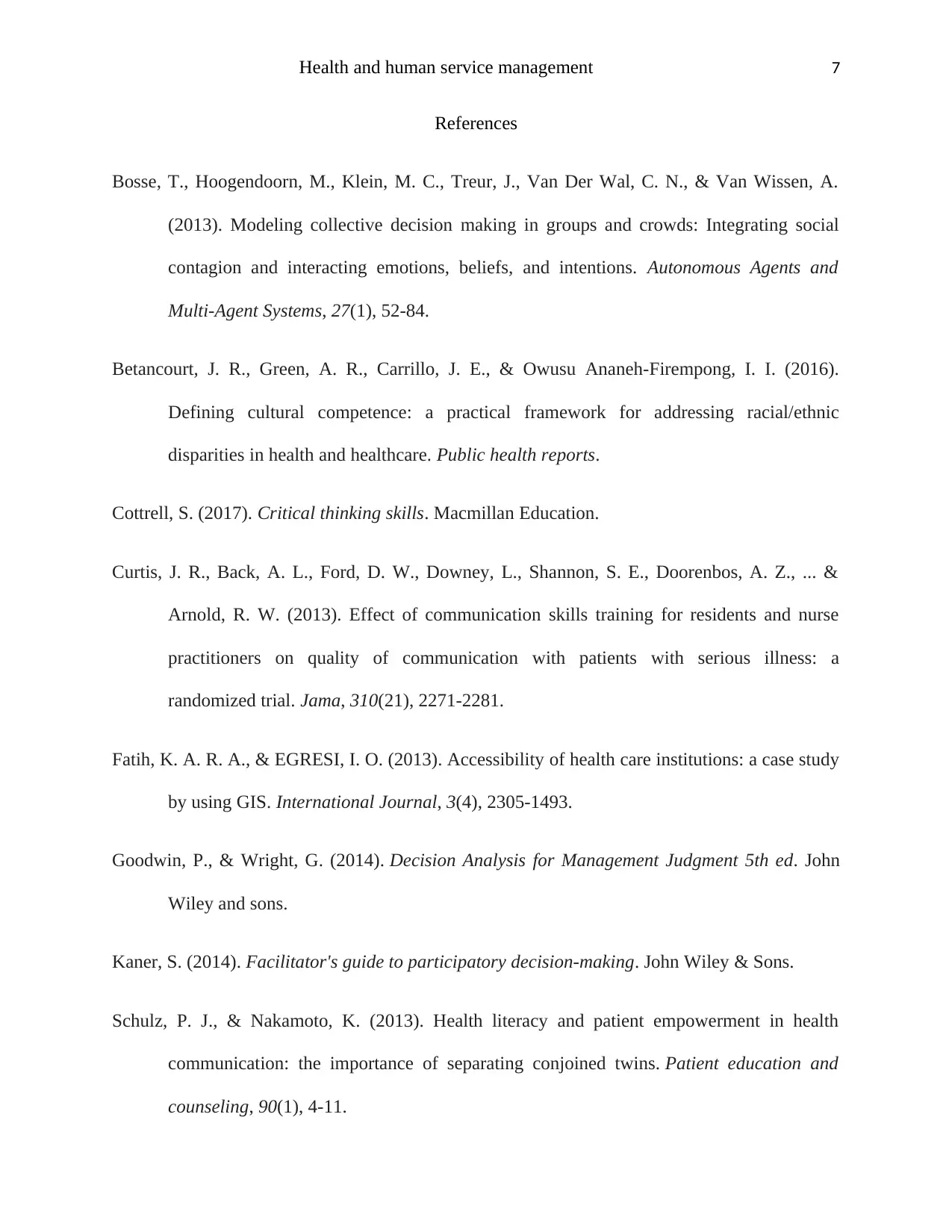
Health and human service management 7
References
Bosse, T., Hoogendoorn, M., Klein, M. C., Treur, J., Van Der Wal, C. N., & Van Wissen, A.
(2013). Modeling collective decision making in groups and crowds: Integrating social
contagion and interacting emotions, beliefs, and intentions. Autonomous Agents and
Multi-Agent Systems, 27(1), 52-84.
Betancourt, J. R., Green, A. R., Carrillo, J. E., & Owusu Ananeh-Firempong, I. I. (2016).
Defining cultural competence: a practical framework for addressing racial/ethnic
disparities in health and healthcare. Public health reports.
Cottrell, S. (2017). Critical thinking skills. Macmillan Education.
Curtis, J. R., Back, A. L., Ford, D. W., Downey, L., Shannon, S. E., Doorenbos, A. Z., ... &
Arnold, R. W. (2013). Effect of communication skills training for residents and nurse
practitioners on quality of communication with patients with serious illness: a
randomized trial. Jama, 310(21), 2271-2281.
Fatih, K. A. R. A., & EGRESI, I. O. (2013). Accessibility of health care institutions: a case study
by using GIS. International Journal, 3(4), 2305-1493.
Goodwin, P., & Wright, G. (2014). Decision Analysis for Management Judgment 5th ed. John
Wiley and sons.
Kaner, S. (2014). Facilitator's guide to participatory decision-making. John Wiley & Sons.
Schulz, P. J., & Nakamoto, K. (2013). Health literacy and patient empowerment in health
communication: the importance of separating conjoined twins. Patient education and
counseling, 90(1), 4-11.
References
Bosse, T., Hoogendoorn, M., Klein, M. C., Treur, J., Van Der Wal, C. N., & Van Wissen, A.
(2013). Modeling collective decision making in groups and crowds: Integrating social
contagion and interacting emotions, beliefs, and intentions. Autonomous Agents and
Multi-Agent Systems, 27(1), 52-84.
Betancourt, J. R., Green, A. R., Carrillo, J. E., & Owusu Ananeh-Firempong, I. I. (2016).
Defining cultural competence: a practical framework for addressing racial/ethnic
disparities in health and healthcare. Public health reports.
Cottrell, S. (2017). Critical thinking skills. Macmillan Education.
Curtis, J. R., Back, A. L., Ford, D. W., Downey, L., Shannon, S. E., Doorenbos, A. Z., ... &
Arnold, R. W. (2013). Effect of communication skills training for residents and nurse
practitioners on quality of communication with patients with serious illness: a
randomized trial. Jama, 310(21), 2271-2281.
Fatih, K. A. R. A., & EGRESI, I. O. (2013). Accessibility of health care institutions: a case study
by using GIS. International Journal, 3(4), 2305-1493.
Goodwin, P., & Wright, G. (2014). Decision Analysis for Management Judgment 5th ed. John
Wiley and sons.
Kaner, S. (2014). Facilitator's guide to participatory decision-making. John Wiley & Sons.
Schulz, P. J., & Nakamoto, K. (2013). Health literacy and patient empowerment in health
communication: the importance of separating conjoined twins. Patient education and
counseling, 90(1), 4-11.
Paraphrase This Document
Need a fresh take? Get an instant paraphrase of this document with our AI Paraphraser
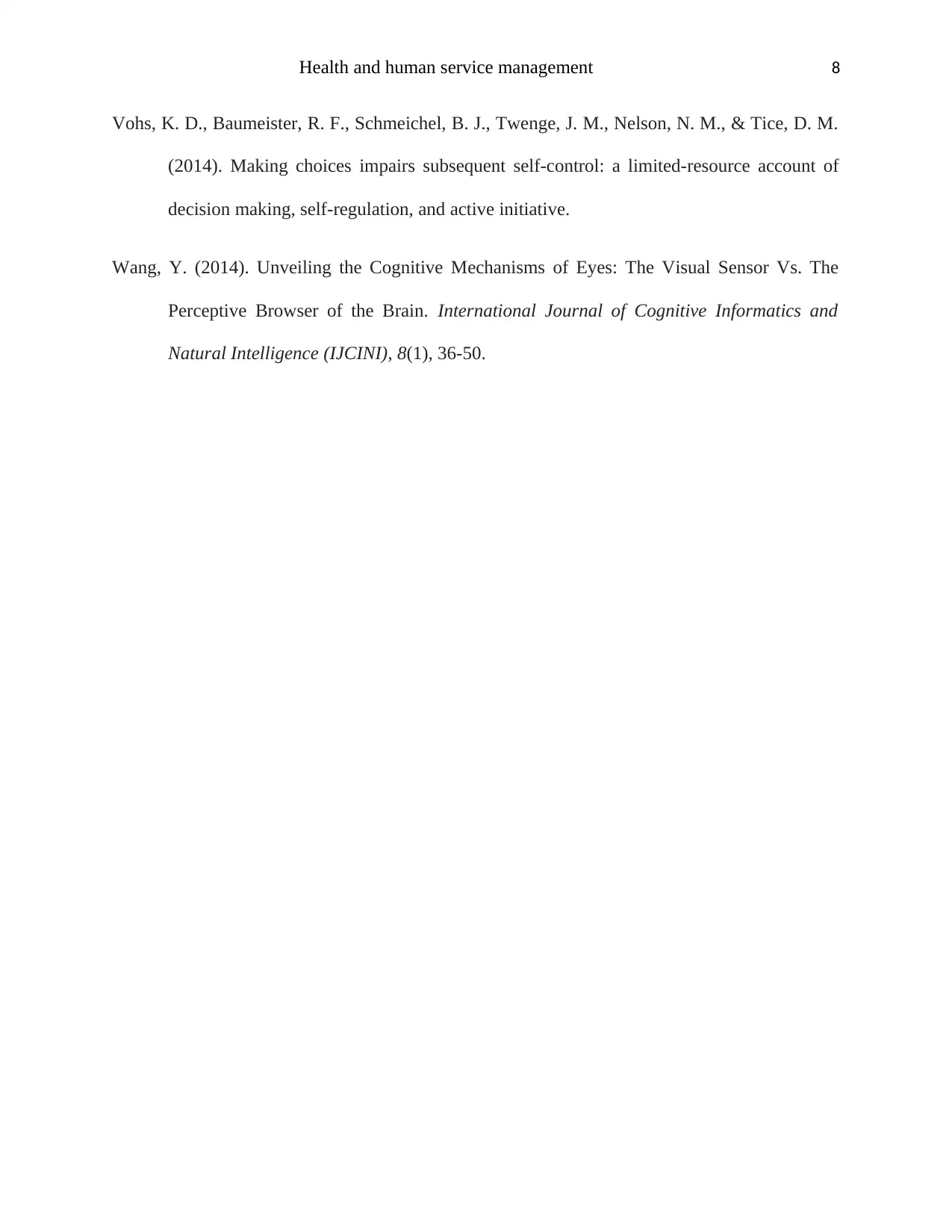
Health and human service management 8
Vohs, K. D., Baumeister, R. F., Schmeichel, B. J., Twenge, J. M., Nelson, N. M., & Tice, D. M.
(2014). Making choices impairs subsequent self-control: a limited-resource account of
decision making, self-regulation, and active initiative.
Wang, Y. (2014). Unveiling the Cognitive Mechanisms of Eyes: The Visual Sensor Vs. The
Perceptive Browser of the Brain. International Journal of Cognitive Informatics and
Natural Intelligence (IJCINI), 8(1), 36-50.
Vohs, K. D., Baumeister, R. F., Schmeichel, B. J., Twenge, J. M., Nelson, N. M., & Tice, D. M.
(2014). Making choices impairs subsequent self-control: a limited-resource account of
decision making, self-regulation, and active initiative.
Wang, Y. (2014). Unveiling the Cognitive Mechanisms of Eyes: The Visual Sensor Vs. The
Perceptive Browser of the Brain. International Journal of Cognitive Informatics and
Natural Intelligence (IJCINI), 8(1), 36-50.
1 out of 8
Related Documents
Your All-in-One AI-Powered Toolkit for Academic Success.
+13062052269
info@desklib.com
Available 24*7 on WhatsApp / Email
![[object Object]](/_next/static/media/star-bottom.7253800d.svg)
Unlock your academic potential
Copyright © 2020–2025 A2Z Services. All Rights Reserved. Developed and managed by ZUCOL.





